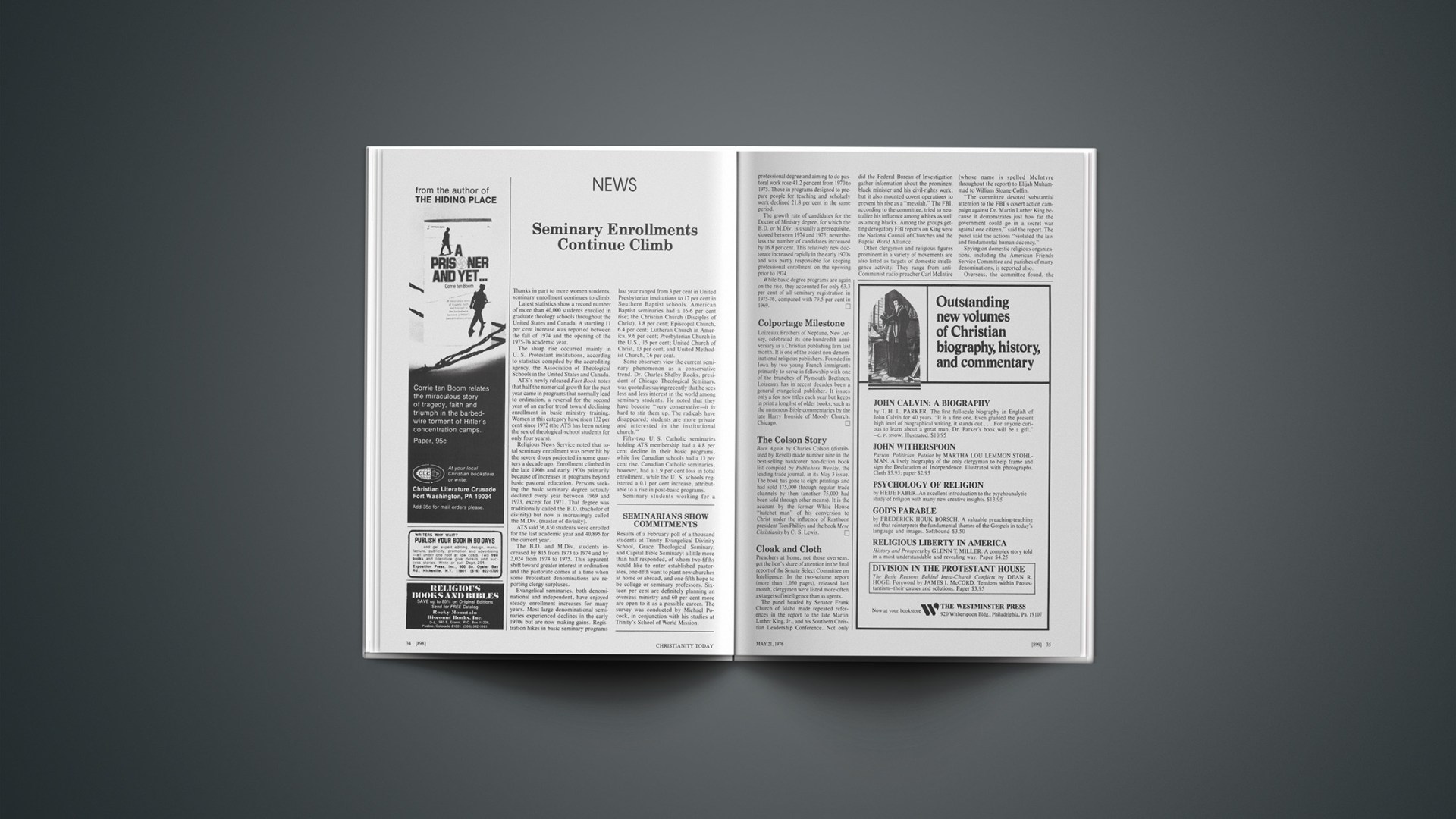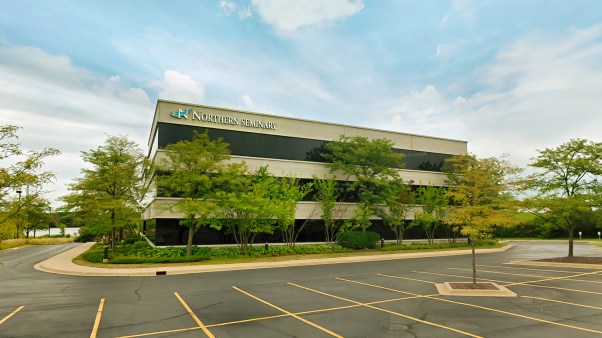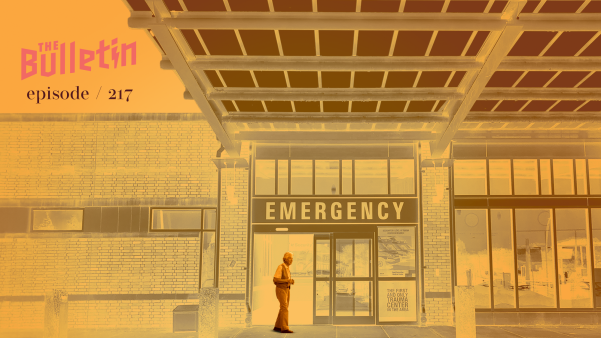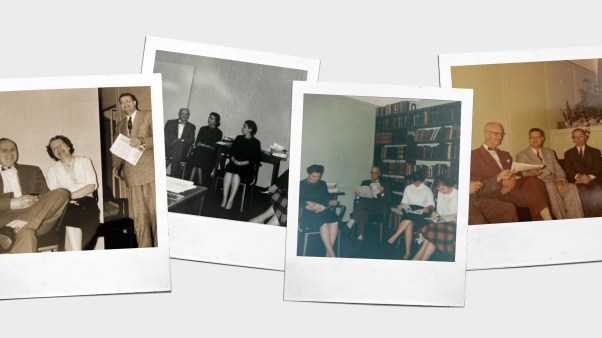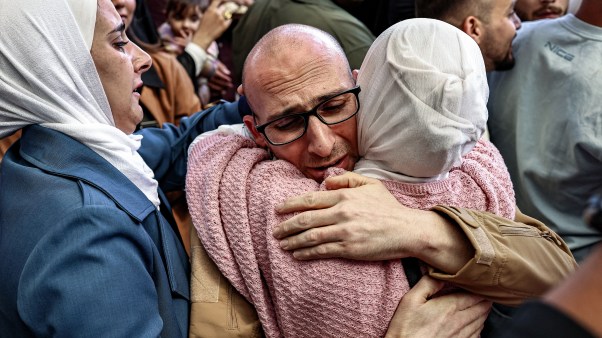Thanks in part to more women students, seminary enrollment continues to climb.
Latest statistics show a record number of more than 40,000 students enrolled in graduate theology schools throughout the United States and Canada. A startling 11 per cent increase was reported between the fall of 1974 and the opening of the 1975–76 academic year.
The sharp rise occurred mainly in U. S. Protestant institutions, according to statistics compiled by the accrediting agency, the Association of Theological Schools in the United States and Canada.
ATS’s newly released Fact Book notes that half the numerical growth for the past year came in programs that normally lead to ordination, a reversal for the second year of an earlier trend toward declining enrollment in basic ministry training. Women in this category have risen 132 per cent since 1972 (the ATS has been noting the sex of theological-school students for only four years).
Religious News Service noted that total seminary enrollment was never hit by the severe drops projected in some quarters a decade ago. Enrollment climbed in the late 1960s and early 1970s primarily because of increases in programs beyond basic pastoral education. Persons seeking the basic seminary degree actually declined every year between 1969 and 1973, except for 1971. That degree was traditionally called the B.D. (bachelor of divinity) but now is increasingly called the M.Div. (master of divinity).
ATS said 36,830 students were enrolled for the last academic year and 40,895 for the current year.
The B.D. and M.Div. students increased by 815 from 1973 to 1974 and by 2,024 from 1974 to 1975. This apparent shift toward greater interest in ordination and the pastorate comes at a time when some Protestant denominations are reporting clergy surpluses.
Evangelical seminaries, both denominational and independent, have enjoyed steady enrollment increases for many years. Most large denominational seminaries experienced declines in the early 1970s but are now making gains. Registration hikes in basic seminary programs last year ranged from 3 per cent in United Presbyterian institutions to 17 per cent in Southern Baptist schools. American Baptist seminaries had a 16.6 per cent rise; the Christian Church (Disciples of Christ), 3.8 per cent; Episcopal Church, 6.4 per cent; Lutheran Church in America, 9.6 per cent; Presbyterian Church in the U.S., 15 per cent; United Church of Christ, 13 per cent, and United Methodist Church, 7.6 per cent.
Some observers view the current seminary phenomenon as a conservative trend. Dr. Charles Shelby Rooks, president of Chicago Theological Seminary, was quoted as saying recently that he sees less and less interest in the world among seminary students. He noted that they have become “very conservative—it is hard to stir them up. The radicals have disappeared; students are more private and interested in the institutional church.”
Fifty-two U. S. Catholic seminaries holding ATS membership had a 4.8 per cent decline in their basic programs, while five Canadian schools had a 13 per cent rise. Canadian Catholic seminaries, however, had a 1.9 per cent loss in total enrollment, while the U. S. schools registered a 0.1 per cent increase, attributable to a rise in post-basic programs.
Seminary students working for a professional degree and aiming to do pastoral work rose 41.2 per cent from 1970 to 1975. Those in programs designed to prepare people for teaching and scholarly work declined 21.8 per cent in the same period.
The growth rate of candidates for the Doctor of Ministry degree, for which the B.D. or M.Div. is usually a prerequisite, slowed between 1974 and 1975; nevertheless the number of candidates increased by 16.8 per cent. This relatively new doctorate increased rapidly in the early 1970s and was partly responsible for keeping professional enrollment on the upswing prior to 1974.
While basic degree programs are again on the rise, they accounted for only 63.3 per cent of all seminary registration in 1975–76, compared with 79.5 per cent in 1969.
SEMINARIANS SHOW COMMITMENTS
Results of a February poll of a thousand students at Trinity Evangelical Divinity School, Grace Theological Seminary, and Capital Bible Seminary: a little more than half responded, of whom two-fifths would like to enter established pastorates, one-fifth want to plant new churches at home or abroad, and one-fifth hope to be college or seminary professors. Sixteen per cent are definitely planning an overseas ministry and 60 per cent more are open to it as a possible career. The survey was conducted by Michael Pocock, in conjunction with his studies at Trinity’s School of World Mission.
Colportage Milestone
Loizeaux Brothers of Neptune, New Jersey, celebrated its one-hundredth anniversary as a Christian publishing firm last month. It is one of the oldest non-denominational religious publishers. Founded in Iowa by two young French immigrants primarily to serve in fellowship with one of the branches of Plymouth Brethren, Loizeaux has in recent decades been a general evangelical publisher. It issues only a few new titles each year but keeps in print a long list of older books, such as the numerous Bible commentaries by the late Harry Ironside of Moody Church, Chicago.
The Colson Story
Born Again by Charles Colson (distributed by Revell) made number nine in the best-selling hardcover non-fiction book list compiled by Publishers Weekly, the leading trade journal, in its May 3 issue. The book has gone to eight printings and had sold 175,000 through regular trade channels by then (another 75,000 had been sold through other means). It is the account by the former White House “hatchet man” of his conversion to Christ under the influence of Raytheon president Tom Phillips and the book Mere Christianity by C. S. Lewis.
Cloak And Cloth
Preachers at home, not those overseas, got the lion’s share of attention in the final report of the Senate Select Committee on Intelligence. In the two-volume report (more than 1,050 pages), released last month, clergymen were listed more often as targets of intelligence than as agents.
The panel headed by Senator Frank Church of Idaho made repeated references in the report to the late Martin Luther King, Jr., and his Southern Christian Leadership Conference. Not only did the Federal Bureau of Investigation gather information about the prominent black minister and his civil-rights work, but it also mounted covert operations to prevent his rise as a “messiah.” The FBI, according to the committee, tried to neutralize his influence among whites as well as among blacks. Among the groups getting derogatory FBI reports on King were the National Council of Churches and the Baptist World Alliance.
Other clergymen and religious figures prominent in a variety of movements are also listed as targets of domestic intelligence activity. They range from anticommunist radio preacher Carl McIntire (whose name is spelled McIntyre throughout the report) to Elijah Muhammad to William Sloane Coffin.
“The committee devoted substantial attention to the FBI’s covert action campaign against Dr. Martin Luther King because it demonstrates just how far the government could go in a secret war against one citizen,” said the report. The panel said the actions “violated the law and fundamental human decency.” Spying on domestic religious organizations, including the American Friends Service Committee and parishes of many denominations, is reported also.
Overseas, the committee found, the Central Intelligence Agency “has used very few religious personnel for operational purposes.” The CIA reported to the panel that “only twenty-one such individuals have ever participated in either covert action projects or the clandestine collection of intelligence.”
One of the panel’s recommendations is that Congress enact into law the CIA’s recently announced prohibition on covert paid or contractual relationships between itself and any American clergymen or missionaries.
The report revealed the names of no overseas religious operatives. It said, however, that by last August the number of Americans “following religious vocations” who furnished information to the agency was down to four. The new policy of hiring no U. S. missionaries was announced this February.
While no further identification is given, the report mentions “the pastor of a church in a Third World country” who received a CIA salary averaging $11,414 over a ten-year period. He was described as a “principal agent” to carry out covert action projects, including passing on CIA propaganda to the press.
Nun Charged With Death Of Infant Son
A newborn male infant was found smothered to death last month in the room of a nun in a suburb of Rochester, New York. Police charged Sister Carol Murphy, 35, director of a nursery school, with second-degree murder.
Police said the nun was found bleeding profusely and taken to a hospital. Medical examination showed she had given birth, but she reportedly denied it.
A search of her room produced the baby’s body. He had been placed in a plastic hamper with underclothes stuffed in his mouth and a blue nightgown wrapped around his neck, police said.
Latter Day Saints: Sex And Succession
Something’s got to give in the 213,399-member Reorganized Church of Jesus Christ of Latter Day Saints. A key aspect of the church’s claim to authenticity is that each of its presidents has been a direct male descendant of founder Joseph Smith. Rival Utah Mormons (The Church of Jesus Christ of Latter-day Saints) have never quite been forgiven for handing over the reins to Brigham Young. Now, however, the Reorganized Church is about to have to decide whether to stray genealogically or to give the office to a woman. The president-designate has no sons.
W. Wallace Smith, 75, has announced he will retire. That alone sets a precedent because until now every head of the church has served till his death. The transfer of powers is scheduled to take place in 1978. At that time Smith will be succeeded by his only son, Dr. Wallace B. Smith, an eye surgeon. The son and his wife have three daughters. They are in their forties and are believed unlikely to have any more children.
The Reorganized Church, unlike Utah Mormonism, permits blacks to be priests, but like the Salt Lake City group bars women from the priesthood. Moves were afoot last month to relax the restriction as the denomination held its 146th world conference in its headquarters auditorium in Independence, Missouri.
Delegates gave final authorization to purchase control of Park College, formerly owned by United Presbyterians. They also heard the president criticize members and priests who have lately begun drinking table wine.
The Capital’S Cardinal
The newest Roman Catholic cardinal in the United States and the only American in a class of nineteen announced April 27 will be remembered by evangelicals primarily for his early interest in the Key 73 evangelistic drive. William Baum, now archbishop of Washington, D. C., headed a small diocese in Missouri at the time, and Key 73 headquarters offices were located in St. Louis. He made the diocese an official participant, one of five representing Roman Catholicism in the endeavor.
The 49-year-old Baum came to Washington in 1973 when the evangelistic effort was in progress. When he came under fire for purchasing a $525,000 mansion as his official residence, he reconsidered and moved into more modest quarters. The original house was subsequently purchased by a group of evangelicals and turned into what is now known as the Christian Embassy.
Father Groppi Marries
The Milwaukee priest who gained prominence as a protester said last month he had become a husband. Father James Groppi, 45, disclosed that he had married Margaret Rozga, 30, in Las Vegas on April 22.
The wedding, a civil ceremony, apparently incurred automatic excommunication for Groppi, although the couple is now trying to get the marriage sanctioned by Roman Catholic authorities.
“Peggy has gone through the protest movement with me for ten years and we are very much in love,” he said, “but we want to stay in the Catholic Church.”
Mrs. Groppi, an English teacher, is a doctoral candidate at the University of Wisconsin.
Groppi attracted wide attention while leading demonstrations against racial discrimination and the war in Viet Nam.
The Virginians And The Vatican
How much freedom does a local Catholic congregation have in determining its own programs and policies? Before Vatican II the answer was a clear “none.” Parish programming was directed by the clergy in accord with the wishes of the diocesan bishop and his staff. In many cases the laity was given an advisory voice, but not a vote.
As a result of Vatican II, however, lay church members were allowed to have more say in parish affairs, a development welcomed by progressives among the clergy and hierarchy. The degree of self-determination generally has depended on the attitudes of the pastor and his bishop.
Understandably, the new freedoms are a source of tensions between liberals and conservatives, and in one long-simmering dispute an unprecedented appeal has been made for Vatican intervention.
The case involves the 800-family Good Shepherd parish near Mount Vernon, Virginia. Until the fall of 1974. Good Shepherd was known as the most progressive—and controversial—church in the entire diocese. Led by flamboyant pastor Thomas Quinlan, the congregation had developed innovative liturgical practices. Lay women ministers distributed the communion elements (allowed under Vatican II), and an elected forty-member parish council formulated policy and directed the church’s affairs.
In a reshuffling of diocesan boundary lines, Quinlan left, and the new overseer. Bishop Thomas Welsh of Arlington diocese, replaced him with Thomas Hannan, a conservative.
On his first Sunday as pastor in September, 1974, Hannan announced sweeping changes aimed at revamping parish styles along more traditional lines. Opposition developed, and a few months later Hannan—with Welsh’s approval—dismissed the parish council. In the ensuing furor, many parishioners participated in a collection-plate boycott.
Negotiators succeeded in hammering out a compromise agreement in January, 1975, in which the council was reactivated and given a “shared ministry” role.
Soon after the pact was agreed upon, Hannan was transferred, and Thomas F. Egan, the church’s new co-pastor, became pastor. He was seen as more moderate than Hannan, but stress still characterized relationships. On one occasion, Welsh publicly questioned the recipe used for Good Shepherd’s communion bread. Last fall, Egan went on an extended leave because of illness that Welsh attributed in part to the strains of shepherding Good Shepherd. Welsh appointed parish administrator Frank Mahler, a building-program specialist, to take over for Egan. To the people at Good Shepherd, Mahler’s views and policies were reruns of Hannan’s, and the feud broke into the open again.
In January of this year, two key lay members of the ministerial staff quit. Joe and Mercedes Iannone, nationally known in Catholic circles for their work as religious-education directors of the parish, claim that Mahler and Welsh welshed on the conditions of the reconciliation pact, a charge Welsh denied. The bishop insisted that he had Good Shepherd’s best interests in mind.
The pocketbook war erupted again, and Mahler terminated all parish committees, axed all spending except that which he personally authorized, and shelved the building program. He also insisted that children of the parish must participate in the ritual of confession of sin before partaking of their first communion, an order passed down by Welsh but one that runs counter to contemporary trends authorized by the nation’s Catholic bishops. More recently, Mahler vetoed proposed liturgical services, then dissolved the parish council when members protested.
Led by Paul Wyche, an employee of the federal Environmental Protection Agency, the ousted council members organized themselves as the “parish-in-exile” and conducted several “alternate” services (including Ash Wednesday on the church parking lot and Easter Sunday on a docked Potomac River cruise boat, both attended by an apparent majority of Good Shepherd’s members). Wyche insists that the exiled council is seeking not to establish a rival parish but only to regain its rights. If necessary, he says, members will seek Welsh’s replacement. Meanwhile, they have launched a newspaper, the catholic connection, in opposition to the official diocesan publication, and they have set up a non-profit corporation, Catholics for Shared Responsibility, to receive funds for religious education and other church-type activities. Clearly, the seeds of schism are being sown.
Acting on an earlier vote of the congregation, some 700 of Good Shepherd’s members who are unhappy with Welsh signed a petition asking Pope Paul to authorize Archbishop William Borders of Baltimore, Welsh’s provincial superior, to investigate the dispute. Apostolic delegate Jean Jadot says the appeal to Rome is a first in U. S. Catholic history.
Early this month the Pope was still pondering his response. To grant the request could be interpreted as undercutting the authority of Welsh (and hence of the church), as traditionally understood. To turn it down would only make matters worse. That dilemma itself underscores the fact that times have changed for the Catholic Church. The question of authority is no longer simply a cut-and-dried matter of unquestioning submission by the faithful to Rome. The faithful are clamoring for equality.
Church Membership Turnaround?
The percentage of the U. S. population holding formal membership in religious bodies rose slightly last year, according to the 1976 Yearbook of American and Canadian Churches.
The increase, from 61.9 per cent in 1974 to 62.3 per cent in 1975, counters a trend of recent years but is not large enough to be considered unusually important. There are enough discrepancies and ambiguities in the compilation of overall church membership statistics to discourage one from drawing major conclusions from relatively minor differences.
Editor Constant H. Jacquet, Jr., issues warnings each year against being too hasty in comparing church growth. According to Jacquet, “only on an individual denomination-by-denomination basis can losses and gains be accurately reported.”
Nevertheless, the new yearbook figures show a record number of 132,287,450 persons as members of 223 religious bodies in the United States.
Two Missionaries Freed
Two American missionaries imprisoned in Mozambique since last summer were released in late April and flown back immediately to the United States.
Hugh Friberg, who serves under the Church of the Nazarene, and Don Milam, who worked with Teen Challenge, were turned over to the U. S. ambassador after prolonged diplomatic negotiations. Another Nazarene missionary, Armand Doll, was still being detained.
A high government official has charged that churches in Mozambique have been involved in a conspiracy against the government that took over when the country gained its independence from Portugal last June. Considerable amounts of printing and audio gear have been confiscated.
The missionaries’ release came during an African tour by U. S. Secretary of State Henry Kissinger during which he said the American government will give Mozambique $12.5 million in aid to help make up for losses suffered from its border closing with Rhodesia. Kissinger also said the United States would assist some 17,000 black Rhodesian refugees in Mozambique.
There was no immediate indication when Doll might be freed; Nazarene officials were assured by the State Department that negotiations would continue.
Milam reportedly ran a government-supported drug-rehabilitation center in Mozambique. Doll had been administrator of the Nazarene mission for more than twenty years.
Muzorewa Skips A Trip
United Methodist bishop Abel Muzorewa of Rhodesia had planned to set aside his political activity in Africa long enough to attend the denomination’s quadrennial General Conference in Portland, Oregon. At the last minute, however, he cabled: “Regret unable to attend General Conference due to pressure of work in the liberation of Zimbabwe” (the name Africans prefer for Rhodesia).
Although the bishop has been living in Mozambique in recent months, his last public statement came from Lusaka, Zambia, in April. In it he blasted Joshua Nkomo, the last leader of the African National Council to negotiate with Rhodesian prime minister Ian Smith. Nkomo, who appeared in the United States with Muzorewa last year, had broken off talks with the white government; nonetheless, the bishop accused him of being “committed to the cause of the enemy.”
After Muzorewa, president of the African National Council, left Rhodesia, Nkomo became known as the spokesman for the group’s “internal” wing. In the latest blast, Muzorewa said there were no “internal” and “external” wings of the ANC.

